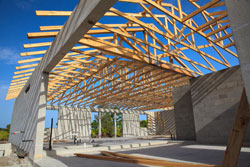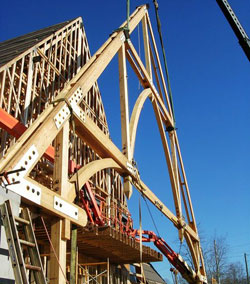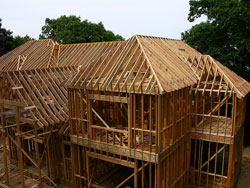High-Performance Wood-Framed Roofs
| Wood and Construction Types | ||||||
The International Building Code (IBC), which has been adopted by most states, gives the design and construction community guidelines on where wood frame buildings are acceptable. Developed in 2000, the IBC has increased opportunities for wood-framed construction, which is allowed not only in residential but light commercial construction and other applications. The IBC identifies five classifications of construction based on types of materials and required fire resistance ratings. Construction types are further divided into A and B, detailing different fire-resistance characteristics, with A representing the more stringent requirements. Types I and II relate primarily to non-combustible materials such as steel and concrete. Multi-story wood construction generally falls into Types III, IV, and V, which allow combustible materials to varying degrees. • Type III (Ordinary) Type III buildings have non-combustible exterior walls and often have a wood roof. This type allows smaller wood members to be used for interior walls, floors, and roofs including wood studs, joists, trusses, and I-joists. Interior building elements are of any material permitted by the IBC. Type IIIA requires 1-hour fire-resistance throughout except that exteriorbearing walls require no less than 2-hour fire-resistive construction. Type IIIB has no fire resistance requirements, except for exterior bearing walls, which has the same requirement as Type IIIA • Type IV (Heavy Timber). Also known as Heavy Timber or HT, Type IV construction utilizes large dimensional lumber for structural members and interior elements. This classification allows the exterior walls to be noncombustible materials and the interior building elements are of solid or laminated wood without concealed spaces. Complying fire retardant-treated wood framing is allowed in exterior wall assemblies with a two-hour rating or less. Interior wood columns, beams, floors, and roofs are required to satisfy certain minimum dimensions and no concealed spaces are permitted. • Type V (Light frame) Type V construction is found in many modern buildings. The walls and roofs are made of combustible materials, most commonly wood. Type V is construction in which the structural elements, exterior walls and interior walls are of any materials permitted by the IBC. The walls, floors, and roofs may be of any dimension lumber and the exterior walls may be of combustible materials. |
Radiant Barriers in a Roof System
A cost-effective green measure for wood-framed roofs that’s being increasingly used is the radiant barrier. Radiant barriers are installed in homes—usually in attics—primarily to reduce summer heat gain, which helps lower cooling costs. The barriers consist of a highly reflective material that reflects, or more specifically re-emits, radiant heating rather than absorbing it. Radiant barriers are available in several forms, including reflective foil, reflective metal roof shingles, reflective laminated roof sheathing, and even reflective chips. The reflective material is usually aluminum and is applied to one or both sides of a number of substrate materials, or can be combined with various types of insulation materials. Architects should note one consideration that is frequently misunderstood: To perform properly, radiant barriers need to face an open space. There must be an air gap between the radiant barrier and the next layer of material. Without an open space between objects, there is no radiant heat, only conductive heat.
Radiant barriers are generally more effective in hot climates than in cool climates, especially when cooling air ducts are located in the attic. Studies have shown that radiant barriers can lower cooling costs by as much as 10 percent in a warm, sunny climate, with the potential to reduce the air conditioning system demand. In cool climates it is more cost effective to install more than the minimum recommended level of insulation rather than a radiant barrier.
According to the U.S. Department of Energy, a radiant barrier's performance is determined by two factors:
Emissivity (or emittance). The ratio of the radiant energy (heat) leaving (being emitted by) a surface to that of a black body at the same temperature and with the same area. It's expressed as a number between 0 and 1. The higher the number, the greater the emitted radiation.
Reflectivity (or reflectance). A measure of how much radiant heat is reflected by a material. It's also expressed as a number between 0 and 1 (sometimes, it is given as a percentage between 0 and 100%). The higher the number, the greater the reflectivity.
The angle the incident radiation strikes the surface—a right angle (perpendicular) usually works best.
All radiant barriers must have a low emissivity (0.1 or less) and high reflectivity (0.9 or more). The greater the temperature differences between the sides of the radiant barrier material, the greater the benefits a radiant barrier can offer.
High Performance in Roofing
High-performance roofing is dependent on a number of factors. But with today’s current practices and products, architects are well equipped to design safe, durable, energy-efficient wood-framed roofs that extend the life of both residential and non-residential buildings.
 |
Huber Engineered Woods LLC, a wholly owned subsidiary of J.M. Huber Corporation, combines advanced resin and wood products technologies with state-of-the-art manufacturing capabilities to develop top quality products like AdvanTech® subflooring and ZIP System® sheathing. Find out more about these innovative products by visiting Huber’s online architect library www.huberarchitectlibrary.com. |











